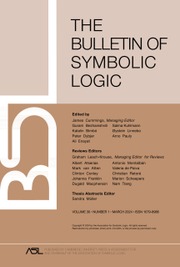Article contents
A MODULAR BISIMULATION CHARACTERISATION FOR FRAGMENTS OF HYBRID LOGIC
Published online by Cambridge University Press: 03 March 2025
Abstract
There are known characterisations of several fragments of hybrid logic by means of invariance under bisimulations of some kind. The fragments include  $\{\mathord {\downarrow }, \mathord {@}\}$ with or without nominals (Areces, Blackburn, Marx),
$\{\mathord {\downarrow }, \mathord {@}\}$ with or without nominals (Areces, Blackburn, Marx),  $\mathord {@}$ with or without nominals (ten Cate), and
$\mathord {@}$ with or without nominals (ten Cate), and  $\mathord {\downarrow }$ without nominals (Hodkinson, Tahiri). Some pairs of these characterisations, however, are incompatible with one another. For other fragments of hybrid logic no such characterisations were known so far. We prove a generic bisimulation characterisation theorem for all standard fragments of hybrid logic, in particular for the case with
$\mathord {\downarrow }$ without nominals (Hodkinson, Tahiri). Some pairs of these characterisations, however, are incompatible with one another. For other fragments of hybrid logic no such characterisations were known so far. We prove a generic bisimulation characterisation theorem for all standard fragments of hybrid logic, in particular for the case with  $\mathord {\downarrow }$ and nominals, left open by Hodkinson and Tahiri. Our characterisation is built on a common base and for each feature extension adds a specific condition, so it is modular in an engineering sense.
$\mathord {\downarrow }$ and nominals, left open by Hodkinson and Tahiri. Our characterisation is built on a common base and for each feature extension adds a specific condition, so it is modular in an engineering sense.
Information
- Type
- Article
- Information
- Copyright
- © The Author(s), 2025. Published by Cambridge University Press on behalf of The Association for Symbolic Logic
References
- 2
- Cited by


